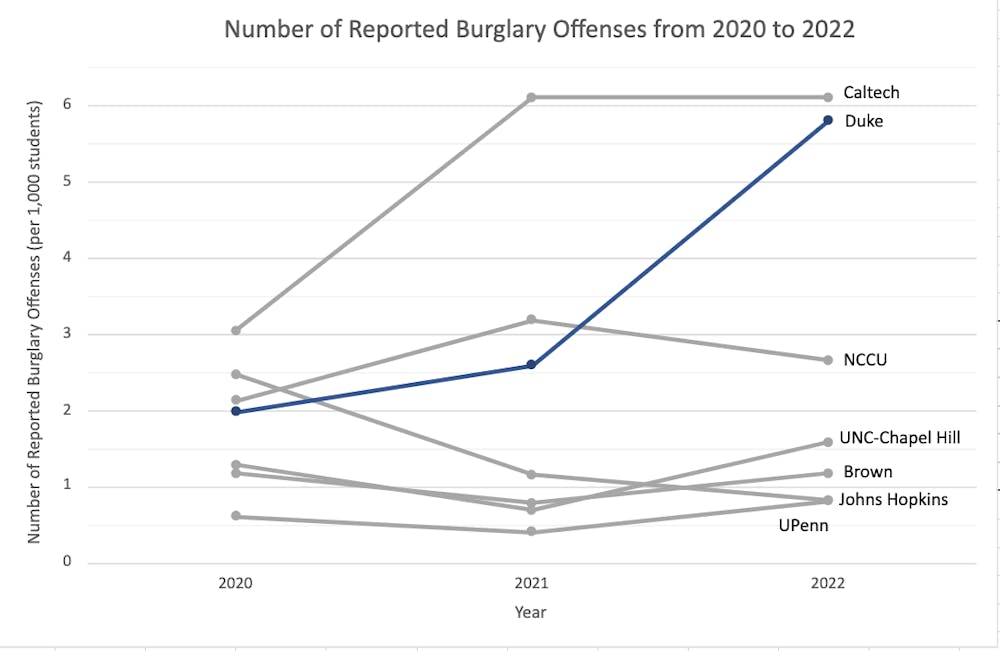Duke recently released its 2023 Annual Security Report, which details on-campus crime statistics for the past three years.
The Annual Security Report is mandated by the Jeanne Clery Act of 1990, which requires all universities who receive federal funding to annually publish their crime statistics from the previous three years, along with information relating to crime policies and incidence reporting.
Duke saw increased incidents of on-campus burglary, fondling and domestic violence and decreased instances of on-campus liquor law violations. Additionally, Duke’s average crime rates within those categories were generally higher than those of peer universities.
The Clery Act defines “on-campus” crime as incidents occurring at residential facilities, health and medical facilities, parking lots, open areas and non-residential facilities on a university’s academic campus. Duke’s 2023 report divides crime into two sections: offenses and arrests/referrals.
2020-22 offenses
On-campus incidents of burglary, fondling and domestic violence exhibited a sustained increase from 2020 to 2022. For all three crimes, the increase from 2021 to 2022 was greater than that from 2020 to 2021.

According to Duke’s 2020 Annual Security Report, fondling incidents at the University were on the decline from 2017 to 2019. Fondling incidents began increasing in 2020, when reported incidents rose from four in 2020 to 12 in 2022. According to John Dailey, Duke University Police Department’s chief of police, cases were reported by both students and employees. In all incidents, the offenders were identified.
Incidents of burglary exhibited the highest increase. The 13 reported offenses in 2020 deviated from past trends by almost tripling over the next three years, reaching 38 incidents in 2022. Burglary offenses at Duke were falling before 2020, when they reached the lowest number in five years. Dailey wrote that most of the cases reported in 2022 occurred within Duke Hospital facilities, with only three out of the 38 incidents involving student victims. In 32 of these cases, there was “little to no theft.”
Domestic violence incidents increased from nine cases in 2020 to 26 in 2022. Dailey noted that nine out of the 26 cases in 2022 were reported by students, with the rest involving campus visitors, family members or Duke hospital patients.
2022 also saw three instances of arson, with one reported incident in 2021 and none reported in 2020. Eight instances of rape were reported in 2022, up from five in 2021 but down from the 11 reported in 2020. Reports of stalking, including cyberstalking, generally remained consistent, with 34 instances reported in 2022, 38 in 2021 and 29 in 2020.
2020-22 arrests and referrals

Liquor law violation referrals were on the decline, dropping by 131 incidents over the past three years. 2022 saw a record low for the past five years with 188 referrals reported.
Additionally, drug law violation referrals increased, though in smaller increments compared to liquor law violation referrals. Referrals increased from 31 referrals in 2020 to 37 referrals in 2022. Despite this recent trend, each annual total of drug law violation referrals from 2020-22 was lower than the annual totals observed in 2017-19, during which totals ranged from 50 in 2019 and 84 in 2018.
How Duke's crime rates compare to other universities
To understand how Duke’s crime rates size up to peer and neighboring institutions, The Chronicle compared the crime statistics at Duke from 2020 to 2022 to those at the California Institute of Technology, University of Pennsylvania, Brown University, Johns Hopkins University, University of North Carolina at Chapel Hill and North Carolina Central University.
The first four institutions were chosen given their similar rankings to Duke, whereas UNC and NCCU were chosen for their geographical proximity.
To account for variation in the undergraduate populations of each institution, statistics for each crime were converted into the number of incidents per 1,000 students per year.
Four crimes were chosen to investigate in-depth: burglary, fondling, domestic violence and liquor law violation referrals. These were selected because they demonstrated the most significant trends in Duke’s data. Additionally, the numbers recorded of these offenses were consistently greater than zero, unlike other crimes like murder and incest.
Burglary

Duke had the greatest increase in burglary rate from 2021 to 2022 compared to the rest of the schools, with an average burglary rate across the three years at 3.46 offenses per thousand students per year. Duke’s rate was the second highest among the seven schools, exceeded only by Caltech’s average rate of 5.09. The University of Pennsylvania held the lowest rate at 0.61.
Fondling

Duke also has comparatively high rates of fondling offenses. Its average rate, 1.17, is second only to Caltech’s rate of 10.18. The University of Pennsylvania had the lowest average rate at 0.17.
Domestic violence

Duke’s average domestic violence rate, 2.50 offenses per thousand students per year, is the second highest among the compared schools. NCCU has the highest rate at 3.14 offenses per thousand students per year, while Brown, with a rate of 0.09, has the lowest.
Liquor law violation referrals

Duke’s average liquor law violation rate is 40.81 per thousand students per year. Duke holds the second-highest average rate, beneath Caltech’s average of 91.99. The lowest average rate, 5.15, belongs to NCCU.
Possible explanations of crime trends
Crimes like rape, aggravated assault, robbery and motor vehicle theft decreased from 2020 to 2021, but saw small upticks in 2022. One potential explanation for this trend may be the impact the COVID-19 pandemic had on campus life.
Dailey previously told The Chronicle that data showing a decrease in criminal activity between 2020 and 2021 may reflect a decrease due to more limited social interaction during the pandemic.
April-Autumn Jenkins, former gender violence and intervention coordinator at the Women’s Center, previously told The Chronicle that she believes students were less likely to report crimes due to a fear of punishment for violating COVID-19 policies.
“I think people were afraid to report and wanting to not get in trouble. This is especially true from a victim-survivor standpoint,” she said.
Another big change to campus life that occurred between 2020 and 2022 was the introduction of the QuadEx residential model, which began in fall 2022. The system aims to create a more cohesive residential community by linking the first-year dorms on East Campus to the upperclassmen dorms on West.
According to Ben Adams, Senior Associate Dean of Students for QuadEx, the belonging he sees stemming from QuadEx goes hand-in-hand with student safety. When asked about the changes in campus culture that he has observed since the implementation of QuadEx, Adams wrote that there has been a notable increase in student connections and social engagement.
However, Adams cautioned against linking the shifts caused by QuadEx to trends in crime data.
“We take safety and well-being very seriously; and while Clery seeks to provide disclosure of specific Campus Crime Statistics we would not attempt to link that data to QuadEx and the statistics shared in the report,” he wrote.
Get The Chronicle straight to your inbox
Signup for our weekly newsletter. Cancel at any time.
Kate Haver is a Trinity first-year and a university news editor of The Chronicle's 120th volume.

